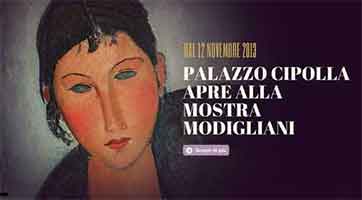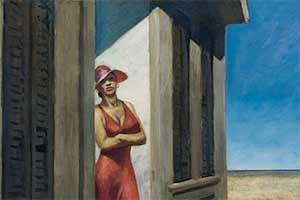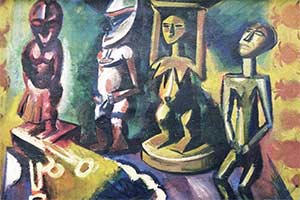Modigliani, Soutine and le artistes maudit

By Professor Francesco Carelli
University of Milan, Rome
“Modigliani, Soutine and les artistes maudit “ , over 100 magnificent works produced in Paris during the Golden Years, during that magical twenty-year period at the beginning of the XX° century when all major artists would convene in Paris cafés to discuss and fight over art. Modern Art was born there, at that time and along those streets: Modigliani, Picasso, Braque, Gauguin, Chagall, Kandinsky and many others: a unique creative excitement, a short circuit that spawned life and timeless masterpieces.
Montparnasse becomes the artists district, dominated by the so-called artistes maudit: Soutine “the filthy”, Valadon and Utrillo “the incestuous”, Vlaminck, Hayden, Solà, Kisling and the most charismatic of all, the handsome and damned Italian, the excessive, passionate and self-destructive Amedeo Modigliani. They all experienced desperate lives and tragic destinies, but each of them found their own way to silence the cry of their souls.
Each artist paints in their own way, but they share the same vibes. And they are still strong. Someone else was also roaming the streets of Paris, Jonas Netter, an affluent merchant who developed a liking for the lives and works of the talented, broke artists. He payed for their food and accommodation, and more often than not he saved their lives: in return, he was given their paintings: he became so fond of them that he never wanted to part from them. Netter ignored that one day these paintings, handed to him in return for a bowl of hot soup, would be worth a fortune. The story of the famed Netter Collection begins here. This collection had been inaccessible up until a few years ago, when the family decided to set up a Foundation targeted at helping out the needy, today as it did back then.
Roma offers a great opportunity to be overwhelmed by the amazing beauty and strength of artistes maudit. The Fondazione who was so generous as to welcome the show in the recently renovated Museo di PalazzoCipolla, promotes the exhibition. . Production and organisation are by Arthemisia Group, which has produced the exhibition in cooperation with the Pinacothèque de Paris and with the contribution from 24 ORE Cultura -Gruppo 24 ORE.
Over 100 works on displa y to reconstruct the path followed by those artists, who lived in a fascinating time for t he history of art in the Montparnasse district at the beginning of the XX°century. Modigliani arrived in Paris in 1906, convinced that that was the place where he will be able to “save his dream”. He settled down in Montparnasse which, in those years, became the art district, not just for painters, but also for writers, such as Hemingway and Miller, intellectuals like Jarry and Cocteau, political refugees like Lenin and Trockij.
The artistsʼ meeting points were cheap taverns and joints-cellars, where artists were discussing art and politics until the small hours and where discussions very often turned into fights. Life conditions were very wretched for everybody, but Modigliani and his comrades found the strength to go on in the sacred fire of art, the awareness that their work was changing aesthetic rules forever.
If Impressionism, despite having introduced a revolution in the way artists painted, in the end did not break free from the rules of naturalism, with the works of Modigliani, Soutine, Utrillo, art became detached from the portrayed subject as well as from the cultural and artistic traditions of the individual artistsʼ countries of origin, thus generating the first true revolution in the art world and turning upside downs all the rules and standard used until then.
This is the context – soon to be defined bohémien -where, as the curator Marc Restellini writes: “These troubled souls express themselves in a painting fed by desperation. At the end of the day, their art is not Polish, Bulgarian, Russian, Italian or French, but rather absolutely original; to put it simply, it is in Paris that they all discover the means of expression that could better translate their own personal vision, sensuality and dreams”.
And again: “Those years feature a time of emancipation and unrest that has remained nearly unique in the history of art. Everywhere in Europe an aesthetic revolution was under way, a prelude to a revolution of behaviours; and it is in Paris, ‘the only place in the world where insurrection is granted the right of citizenship ’, in Montmartre before and in Montparnasse later, that those artists – all Jews – met to take their chances”.
Jonas Netter was also a Jew, a very important figure for the artists on display in the exhibition; without him many of them wouldnʼt have had anything to live on: the exhibition itinerary, subdivided in six sections, features the masterpieces acquired by Jonas Netter during his life; this man, fascinated by art and painting, turned into an enlightened amateur and a sharp talent detector, thanks to his meeting with the Polish art dealer and poet Léopold Zborowski.
Netter met Modigliani, Soutine, Utrillo and had a connection with Valadon, Kisling, Krémègne, Kikoïne, Hayden, Ébiche, Antcher and Fournier. Their production fascinated him and prompted him to support them generously and to purchase their works from the art dealer: he became a sort of would-be “patron”, both inspired and a genius. So much so that when Modigliani was forced to move to the French Riviera for health-related problems, he purchased from the young Italian as many paintings as needed to pay for his stay, during which the artist then worked very hard.
Netter was a great admirer of Modiglianiʼs creative genius, he deeply appreciated his sketched female faces resting on long thin necks, such as Elvire au col blanc (Elvire à la collerette) from 1917-18 and Fillette en robe jaune (Portrait de jeune femme à la collerette) from 1917, both exhibited together with Portrait de Zborowski (1916) and Portrait de Soutine, also painted in 1916 following the meeting of the two artists, who started a long-lasting friendship, so much so that Modigliani introduced Soutine to Netter. The show features over twenty oil paintings by Chaim Soutine – a true exhibition-in-the-exhibition – including L’Homme au chapeau, L’Escalier rouge à Cagnes and La Folle.
If on the one hand we are currently great admirers of these works as absolute art masterpieces, on the other hand it is worth remembering that at the time when they were produced they were considered true monstrosities. This is the reason why Netterʼs intuition resembles a true prophecy, besides being a brave and often unselfish gesture. Not much was known about this man, such was his discretion and reserve.
Because of Netterʼs reserved attitude, none of his personal belongings survived him, except for the work he loved and collected and which we have a chance to admire today.



